Geochemical Characteristics and Origin of Natural Gas in the Middle of Shuntuoguole Low Uplift, Tarim Basin: Evidence from Natural Gas Composition and Isotopes
Abstract
1. Introduction
2. Geological Setting
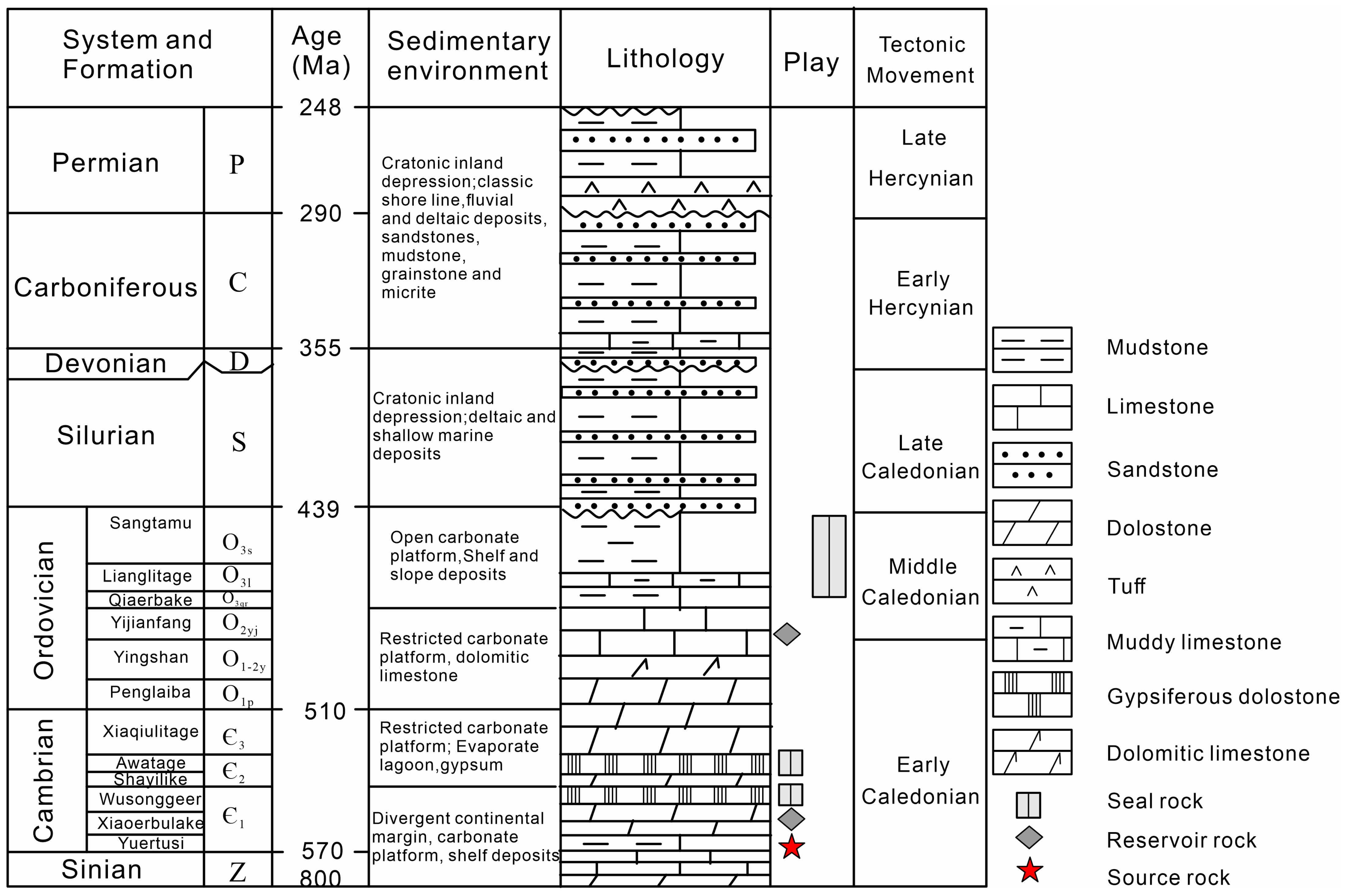
3. Material and Methods
4. Results
4.1. Characteristics of Natural Gas Components
4.2. Carbon Isotope Characteristics of Natural Gas
4.3. Hydrogen Isotope Characteristics of Natural Gas
5. Discussion
5.1. Natural Gas Genesis
5.2. Natural Gas Sources
5.3. Maturity of Natural Gas
5.4. Characteristics of Natural Gas Accumulation
6. Conclusions
- (1)
- The Ordovician ultra-deep natural gas found in the central region of the Shuntuoguole low uplift consists primarily of hydrocarbon gases. Most exhibit a drying coefficient range of 0.41–0.99, classifying them as wet gasses with a relatively low content of non-hydrocarbon gases, primarily consisting of CO2 and N2. Analysis of the carbon and hydrogen isotopes of natural gas alkanes reveals generally lighter isotopic values. Notably, variations in isotopic compositions are observed among different faults and segments of the same fault, displaying a positive distribution. These findings strongly indicate that the natural gas is of organic origin, primarily derived from alkane gas sources.
- (2)
- The ultra-deep natural gas derived from the Ordovician formations in the central part of the Shuntuoguole low uplift is classified as an oil-type gas. The source rock primarily consists of marine sapropelic organic matter. In the Shunbei No. 1, No. 5, and No. 4 fault zones, the δ13C1 value of the natural gas is significantly lighter, indicating its association with normal crude oil-associated gas. The natural gas predominantly comprises kerogen cracking gases, with variations in maturity observed among different fault zones. The No. 1 and No. 5 fault zones exhibit a maturity level of around 1.0% and are characterized by normal crude oil-associated gas in the mature stage. However, the No. 4 and No. 8 fault zones have a higher maturity level above 1.0%, resulting in a mixture of kerogen cracking gas and crude oil cracking gas.
- (3)
- The variations observed in the drying coefficient and carbon isotope of ultra-deep natural gas in different fault zones within the central region of the Shuntuoguole low uplift provide insights into the migration patterns of these gases. Specifically, the Shunbei No. 5 and No. 8 fault zones primarily exhibit a south-to-north migration trend, while the No. 4 fault zone displays migration from the central area to both the north and south sides. The migration of natural gas in this region is strongly influenced by the presence of steep strike-slip faults. It primarily undergoes vertical migration along these faults, eventually accumulating within the fractured reservoirs of the Ordovician formations. Additionally, there is evidence of lateral migration observed from the western depression to the eastern slope, contributing to the distribution of natural gas reservoirs across the area.
Author Contributions
Funding
Data Availability Statement
Acknowledgments
Conflicts of Interest
References
- Pang, X.; Wang, W.; Wang, Y.; Wu, L. Comparison of otherness on hydrocarbon accumulation conditions and characteristics between deep and middle-shallow in petroliferous basins. Acta Pet. Sin. 2015, 36, 1167–1187. [Google Scholar]
- Pang, X.-Q.; Jia, C.-Z.; Wang, W.-Y. Petroleum geology features and research developments of hydrocarbon accumulation in deep petroliferous basins. Pet. Sci. 2015, 12, 1–53. [Google Scholar] [CrossRef]
- Yang, H.; Han, J. Reservoir forming characteristics and main controlling factors of Lunnan compound oil and gas accumulation area in Tarim Basin. Sci. Sin. 2007, 2, 53–62. [Google Scholar]
- Qi, L. Characteristics and inspiration of ultra-deep fault-karst reservoir in the Shunbei area of the Tarim Basin. China Pet. Explor. 2020, 25, 102–111. [Google Scholar]
- Zhu, X.; Cao, Z.; Long, H.; Zeng, J.; Huang, C.; Chen, X. Experimental simulation and characteristics of hydrocarbon accumulation in strike-slip fault zone in Shunbel area, Tarim Basin. Earth Sci. 2023, 30, 289–304. [Google Scholar] [CrossRef]
- Han, J.; Kuang, A.; Neng, Y.; Huang, C.; Li, Q.; Chen, P.; Shen, Z. Vertical Layered Structure of Shunbei No.5 Strike-Slip Fault Zone and Its Significance onHydrocarbon Accumulation. Xinjiang Pet. Geol. 2021, 42, 152–160. [Google Scholar]
- Gu, Y.; Huang, J.; Jia, C.; Shao, Z.; Sun, Y.; Lu, Q. Research progress on marine oil and gas accumulation in Tarim Basin. Pet. Geol. Exp. 2020, 42, 1–12. [Google Scholar]
- Cao, Z.; Lu, Q.; Gu, Y.; Wu, X.; You, D.; Zhu, X. Characteristics of Ordovician reservoirs in Shunbei 1 and 5 fault zones, Tarim Basin. Oil Gas Geol. 2020, 41, 975–984. [Google Scholar]
- Lotfy, N.M.; Farouk, S.; Hakimi, M.H.; Ahmad, F.; El Shennawy, T.; El Nady, M.M.; Salama, A.; Shehata, A.M. Biomarker and isotopic characteristics of Miocene condensates and natural gases, West Delta deep marine concession, Eastern Mediterranean, Egypt. Sci. Rep. 2024, 14, 235. [Google Scholar] [CrossRef]
- Lotfy, N.M.; Qteishat, A.; Farouk, S.; Ahmad, F.; Al-Kahtany, K.; Hsu, C.S. Geochemical characteristics and genetic types of Ordovician tight gas in the Risha Gas Field, Eastern Jordan based on carbon and hydrogen isotope compositions. Mar. Pet. Geol. 2022, 143, 105810. [Google Scholar] [CrossRef]
- Fuex, A.N. The use of stable carbon isotopes in hydrocarbon exploration. J. Geochem. Explor. 1977, 7, 155–188. [Google Scholar] [CrossRef]
- Luo, M.; Xia, Y.; Shao, X.; Wu, X. Geochemical characteristics and origin of oil from different strata in Shunbei oil and gas field, Tarim Basin. Pet. Geol. Exp. 2019, 41, 849–854. [Google Scholar]
- Gu, R.; Yun, L.; Zhu, X.; Zhu, M. Oil and gas sources in Shunbei Oilfield, Tarim Basin. Pet. Geol. Exp. 2020, 42, 248–254+262. [Google Scholar]
- Wang, T.; Song, D.; Li, M.; Yang, C.; Ni, Z.; Li, H.; Cao, Z.; Zhang, B.; Feng, Z. Natural gas source and deep gas exploration potential of the Ordovician Yingshan Formation in the Shunnan-Gucheng region, Tarim Basin. Oil Gas Geol. 2014, 35, 753–762. [Google Scholar]
- Yun, l. Hydrocarbon Accumulation of Ultra-Deep Ordovician Fault-Karst Reservoirs in Shunbei Area. Xinjiang Pet. Geol. 2021, 42, 136–142. [Google Scholar]
- Ma, A.; Jin, Z.; Li, H.; Gu, Y.; Qiu, N.; Zhu, X.; Wu, X.; Yang, X.; Wang, S. Secondary Alteration and Preservation of Ultra-Deep Ordovician Oil Reservoirs of North Shuntuoguole Area of Tarim Basin, NW China. Earth Sci. 2020, 45, 1737–1753. [Google Scholar]
- Ma, A.; Qi, L. Geochemical characteristics and phase behavior of the Ordovician ultra-deep reservoir fluid, No.4 fault, northern Shuntuoguole, Tarim Basin. Earth Sci. Front. 2023, 30, 247–262. [Google Scholar] [CrossRef]
- Wu, C.; Zhao, X.; Wu, G.; Li, F.; Zhang, H.; Hu, Z.; Li, S. Characteristics and distribution of fault-controlled carbonate reservoirs in Yijianfang Formation of Yueman area, northern Tarim Basin. Geol. China 2021, 3, 762–779. [Google Scholar]
- Wei, G.; Zhu, Y.; Zheng, J.; Yu, G.; Ni, X.; Yan, L.; Tian, L.; Huang, L. Tectonic-lithofacies paleogeography, large-scale source-reservoir distribution and exploration zones of Cambrian subsalt formation Tarim Basin, NW China. Pet. Explor. Dev. 2021, 48, 1114–1126. [Google Scholar] [CrossRef]
- Han, X.; Tang, L.; Cao, Z.; Wei, H.; Fu, C. Characteristics and Formation Mechanism of Composite flower Structures in Northern Slope of Tazhong Uplift, Tarim Basin. Earth Sci. 2018, 43, 525–537. [Google Scholar]
- Tang, L.; Qi, L.; Qiu, H.; Yun, L.; Li, M.; Xie, D.; Yang, Y.; Wan, G. Poly-phase differential fault movement and hydrocarbon accumulation of the Tarim Basin, NW China. Acta Petrol. Sin. 2012, 28, 2569–2583. [Google Scholar]
- He, D.; Zhou, X.; Yang, H.; Guan, S.; Zhang, C. Formation mechanism and tectonic types of intracratonic paleo-uplifts in the Tarim basin. Earth Sci. Front. 2008, 2, 207–221. [Google Scholar]
- Qiu, H.; Deng, S.; Cao, Z.; Yin, T.; Zhang, Z. The Evolution of the Complex Anticlinal Belt with Crosscutting Strike-Slip Faults in the Central Tarim Basin, NW China. Tectonics 2019, 38, 2087–2113. [Google Scholar] [CrossRef]
- Yan, L.; Zhu, G.; Chen, Y.; Han, C.; Yang, M.; Du, D.; Zhu, W. Distribution of Lower Cambrian source rocks in the Tarim Basin. Nat. Gas Geosci. 2019, 30, 1569–1578. [Google Scholar]
- Qi, L. Oil and gas breakthrough in ultra-deep Ordovician carbonate formations in Shuntuoguole uplift, Tarim Basin. China Pet. Explor. 2016, 21, 38–51. [Google Scholar]
- Lv, H.; Han, J.; Zhang, J.; Liu, Y.; Li, Y. Development characteristics and formation mechanism of ultra-deep carbonate fault-dissolution body in Shunbei area, Tarim Basin. Pet. Geol. Exp. 2021, 43, 14–22. [Google Scholar]
- Jiao, F. Significance and prospect of ultra-deep carbonate fault-karst reservoirs in Shunbei area, Tarim Basin. Oil Gas Geol. 2018, 39, 207–216. [Google Scholar]
- Jiao, F. Significance of oil and gas exploration in NE strike-slip fault belts in Shuntuoguole area of Tarim Basin. Oil Gas Geol. 2017, 38, 831–839. [Google Scholar]
- Deng, S.; Li, H.; Zhang, Z.; Wu, X.; Zhang, J. Characteristics of differential activities in major strike-slip fault zones and their control on hydrocarbon enrichment in Shunbei area and its surroundings, Tarim Basin. Oil Gas Geol. 2018, 39, 878–888. [Google Scholar]
- Deng, S.; Liu, Y.; Liu, J.; Han, J.; Wang, B.; Zhao, R. Structural styles and Evolution Models of Intracratonic Strike-slip Faults and the Implications for Reservoir Exploration and Appraisal: A Case Study of the Shunbei Area, Tarim Basin. Geotecton. Et Metallog. 2021, 45, 1111–1126. [Google Scholar] [CrossRef]
- Wang, Q.; Hao, F.; Cao, Z.; Tian, J.; Cong, F. Geochemistry and origin of the ultra-deep Ordovician oils in the Shunbei field, Tarim Basin, China: Implications on alteration and mixing. Mar. Pet. Geol. 2021, 123, 104725. [Google Scholar] [CrossRef]
- Shen, P.; Xu, Y.; Wang, X. The Geochemical Characteristics of Gas-Source Rocks and Natural Gases and Gas Generating Mechanism; Science TechniquePress of Gansu: Lanzhou, China, 1991. [Google Scholar]
- Huang, D.; Zhao, M.; Liu, B.; Wang, T.; Chen, S.; Xu, Y. Types of natural gas genesis in the eastern Tarim Basin and their maturity determination. Sci. Sin. 1996, 4, 365–372. [Google Scholar]
- Cao, Z.; Yun, l.; Ping, H.; Li, H.; Geng, F.; Han, J.; Huang, C.; Mao, Q.; Ding, Y. Geochemistry and origin of Ordovician natural gas in Shunbei area of Tarim Basin. Bull. Geol. Sci. Technol. 2024, 1–16. [Google Scholar] [CrossRef]
- Dai, J.; Xia, X.; Qin, S.; Zhao, J. Causation of partly reversed orders of δ13C in biogenic alkane gas in China. Oil Gas Geol. 2003, 1, 1–6+11. [Google Scholar]
- Dai, J.; Zou, C.; Zhang, S.; Li, J.; Ni, Y.; Hu, G.; Luo, X.; Tao, S.; Zhu, G.; Mi, J.; et al. Identification of inorganic and organic hydrocarbon gases. Sci. Sin. 2008, 11, 1329–1341. [Google Scholar]
- Zhu, G.; Chen, F.; Chen, Z.; Zhang, Y.; Xing, X.; Tao, X.; Ma, D. Discovery and basie characteristies of the high quality source rocksof the Cambrian Yuertusi Formation in Tarim Basin. Nat. Gas Geosci. 2016, 27, 8–21. [Google Scholar]
- Dai, J.; Pei, X.; Qi, H. China Natural Gas Geology; Petroleum Industry Press: Beijing, China, 1992; Volume 1. [Google Scholar]
- Li, F.; Zhu, G.; Lv, X.; Zhang, Z.; Wu, Z.; Xue, N.; He, T.; Wang, R. The disputes on the source of Paleozoic marine oil and gas and the determination of the Cambrian system as the main source rock in Tarim Basin. Acta Pet. Sin. 2021, 42, 1417–1436. [Google Scholar]
- Zhang, S.; Zhang, B.; Yang, H.; Zhu, G.; Su, J.; Wang, X. Adjustment and alteration of hydrocarbon reservoirs during the late Himalayan period, Tarim Basin, NW China. Pet. Explor. Dev. 2012, 39, 668–680. [Google Scholar] [CrossRef]
- Dai, J. Significance of the study on carbon isotopes of alkane gases. Nat. Gas Ind. 2011, 31, 1–6+123. [Google Scholar]
- Bernard, B.B.; Brooks, J.M.; Sackett, W.M. Natural gas seepage in the Gulf of Mexico. Earth Planet. Sci. Lett. 1976, 31, 48–54. [Google Scholar] [CrossRef]
- Milkov, A.V.; Etiope, G. Revised genetic diagrams for natural gases based on a global dataset of >20,000 samples. Org. Geochem. 2018, 125, 109–120. [Google Scholar] [CrossRef]
- Whiticar, M.J. Carbon and hydrogen isotope systematics of bacterial formation and oxidation of methane. Chem. Geol. 1999, 161, 291–314. [Google Scholar] [CrossRef]
- Dai, J.; Gong, D.; Ni, Y.; Yu, C.; Wu, W. Genetic Types of the Alkane Gases in Giant Gas Fields with Proven Reserves over 1000 × 108 m3 in China. Energy Explor. Exploit. 2014, 32, 1–18. [Google Scholar] [CrossRef]
- Rooney, M.A.; Claypool, G.E.; Moses Chung, H. Modeling thermogenic gas generation using carbon isotope ratios of natural gas hydrocarbons. Chem. Geol. 1995, 126, 219–232. [Google Scholar] [CrossRef]
- Miao, Z.; Chen, J.; Zhang, C.; Chen, H.; Wang, G. Regularity of distribution and accumulation stages of natural gases in the Lunnan lower uplift of the Tarim Basin. Acta Pet. Sin. 2011, 32, 404–410. [Google Scholar]
- Yang, H.; Chen, Y.; Tian, J.; Du, J.; Zhu, Y.; Li, H.; Pan, W.; Yang, P.; Li, Y.; An, H. Great discovery and its significance of ultra-deep oil and gas exploration in well Luntan-1 of the Tarim Basin. China Pet. Explor. 2020, 25, 62–72. [Google Scholar]
- Li, J.; Li, Z.; Wang, X.; Wang, D.; Xie, Z.; Li, J.; Wang, Y.; Han, Z.; Ma, C.; Wang, Z.; et al. New indexes and charts for genesis identification of multiple natural gases. Pet. Explor. Dev. 2017, 44, 503–512. [Google Scholar] [CrossRef]
- Thompson, K.F.M. Light hydrocarbons in subsurface sediments. Geochim. Et Cosmochim. Acta 1979, 43, 657–672. [Google Scholar] [CrossRef]
- Thompson, K.F.M. Classification and thermal history of petroleum based on light hydrocarbons. Geochim. Cosmochim. Acta 1983, 47, 303–316. [Google Scholar] [CrossRef]
- Gu, Y.; Wan, Y.; Huang, J.; Zhuang, X.; Wang, B.; Li, M. Oil and gas exploration prospect of ultra deep layer in Tarim Basin under the condition of large burial depth and high pressure. Pet. Geol. Exp. 2019, 41, 157–164. [Google Scholar]
- Zhu, G.; Li, T.; Zhang, Z.; Zhao, K.; Zhang, K.; Chen, W.; Yan, H.; Wang, P. Distribution and geodynamic setting of the Late Neoproterozoic–Early Cambrian hydrocarbon source rocks in the South China and Tarim Blocks. J. Asian Earth Sci. 2020, 201, 104504. [Google Scholar] [CrossRef]
- Xiong, R.; Zhou, J.; Ni, X.; Zhu, Y.; Chen, Y. Distribution prediction of Lower Cambrian Yuertusi Formation source rocks and its significance to oil and gas exploration in the Tarim Basin. Nat. Gas Ind. 2015, 35, 49–56. [Google Scholar]
- Ma, A.L. Kinetics of oil-cracking of different types of marine oils from Tahe Oilfield, Tarim Basin, NW China. Nat. Gas Geosci. 2015, 26, 1120–1128. [Google Scholar] [CrossRef]
- Zhu, G.; Zhang, S.; Su, J.; Huang, H.; Yang, H.; Gu, L.; Zhang, B.; Zhu, Y. The occurrence of ultra-deep heavy oils in the Tabei Uplift of the Tarim Basin, NW China. Org. Geochem. 2012, 52, 88–102. [Google Scholar] [CrossRef]
- Ma, A.; He, Z.; Yun, L.; Wu, X.; Li, H.; Qiu, N.; Chang, J.; Lin, H.; Cao, Z.; Zhu, X.; et al. The geochemical characteristics and origin of Ordovician ultra-deep natural gas in the North Shuntuoguole area, Tarim Basin, NW China. Nat. Gas Geosci. 2021, 32, 1047–1060. [Google Scholar] [CrossRef]
- Hou, D.; Feng, Z. Petroleum Geochemistry; Petroleum Industry Press: Beijing, China, 2011. [Google Scholar]
- Peng, W.; Liu, Q.; Hu, G.; Lv, Y.; Zhu, D.; Meng, Q.; Guo, F.; Wang, R. Mechanisms of carbon isotope fractionation in the process of natural gas generation: Geochemical evidence from thermal simulation experiment. Pet. Explor. Dev. 2020, 47, 972–983. [Google Scholar] [CrossRef]
- Qin, S.; Tang, X.; Song, Y.; Wang, H. Distribution and fractionation mechanism of stable carbon isotope of coalbed methane. Sci. China Ser. D Earth Sci. 2006, 49, 1252–1258. [Google Scholar] [CrossRef]
- Bian, J.; Hou, D.; Cheng, X.; Jia, Z. Origin of the Ultra-Deep Hydrocarbons from the Shunbei No. 1 Fracture Zone in the North of Shuntuoguole Low Uplift, Tarim Basin, North-Western China. Appl. Sci. 2023, 13, 5297. [Google Scholar] [CrossRef]
- Bian, J.; Hou, D.; Cui, Y.; Zhu, X. Geochemical characteristics and origin of the ultra-deep hydrocarbons from the Shunbei Oilfield in the Tarim Basin, China: Insight from molecular biomarkers and carbon isotope geochemistry. Mar. Pet. Geol. 2023, 158, 106542. [Google Scholar] [CrossRef]
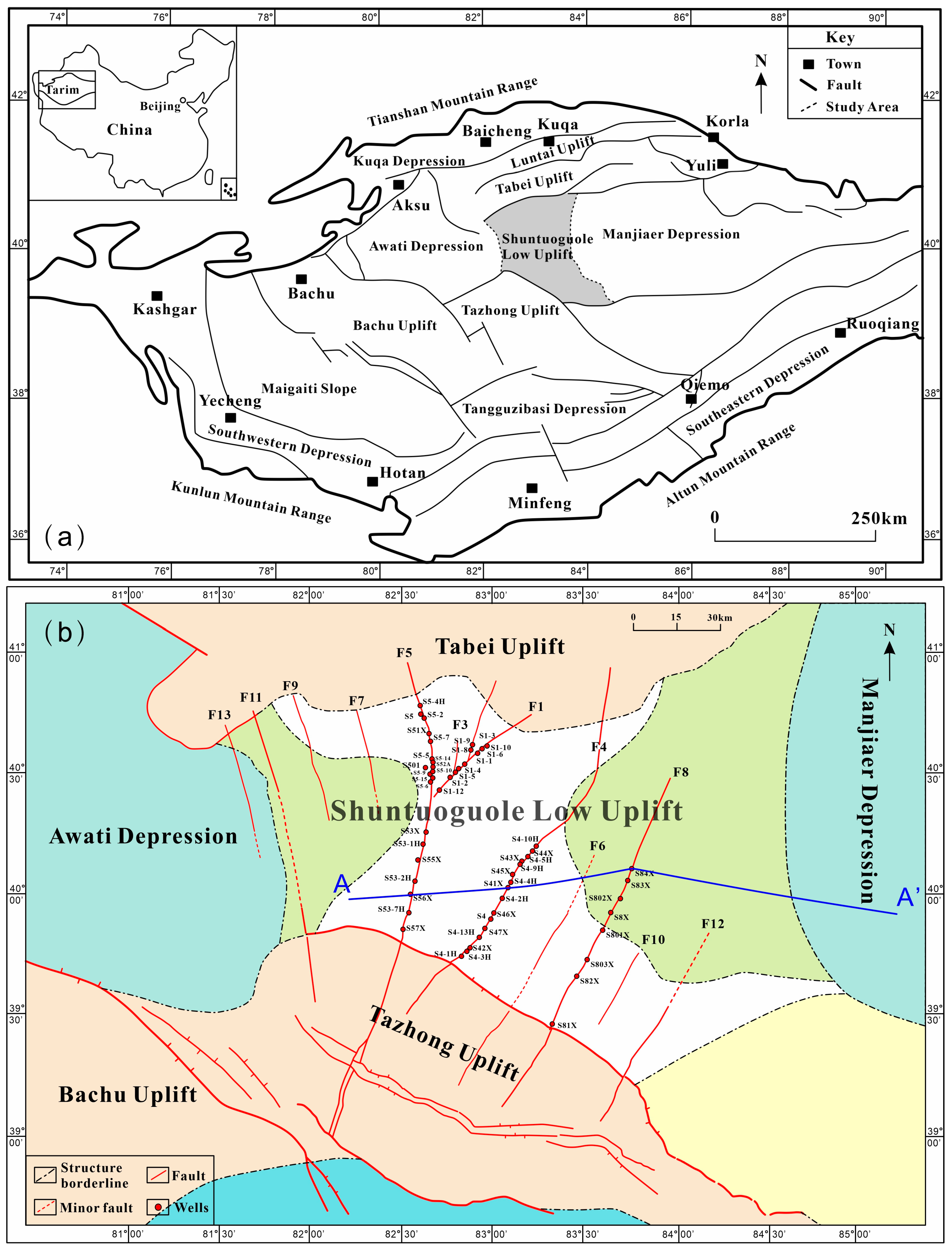

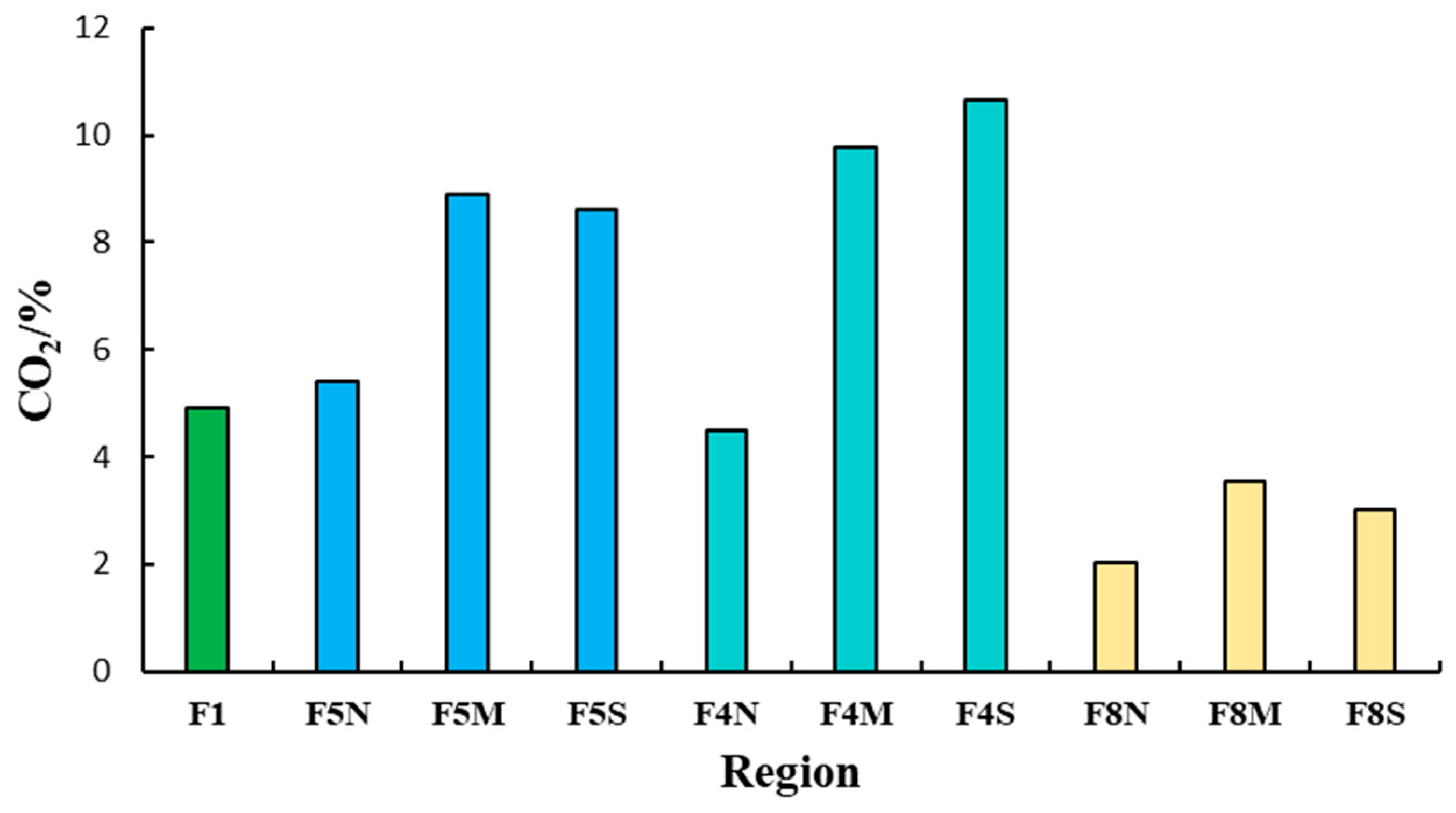



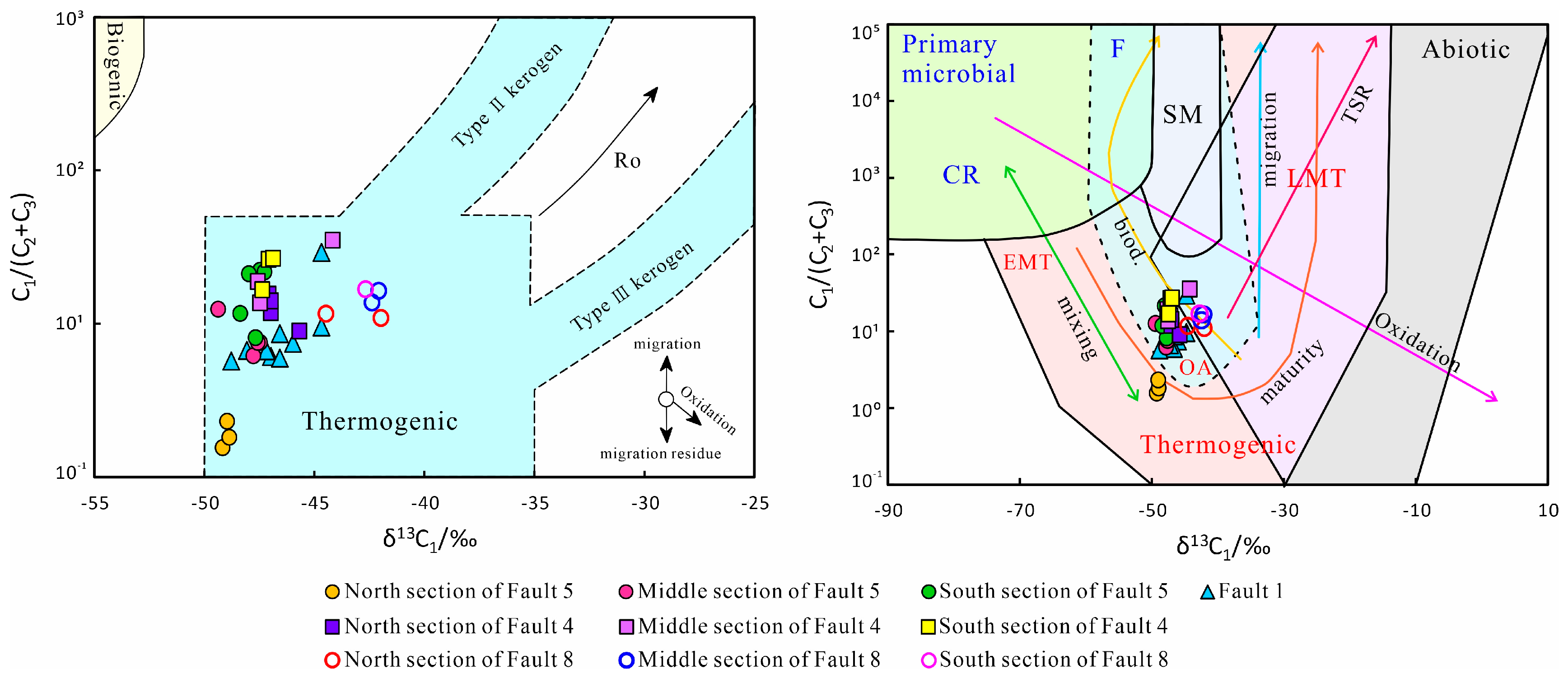
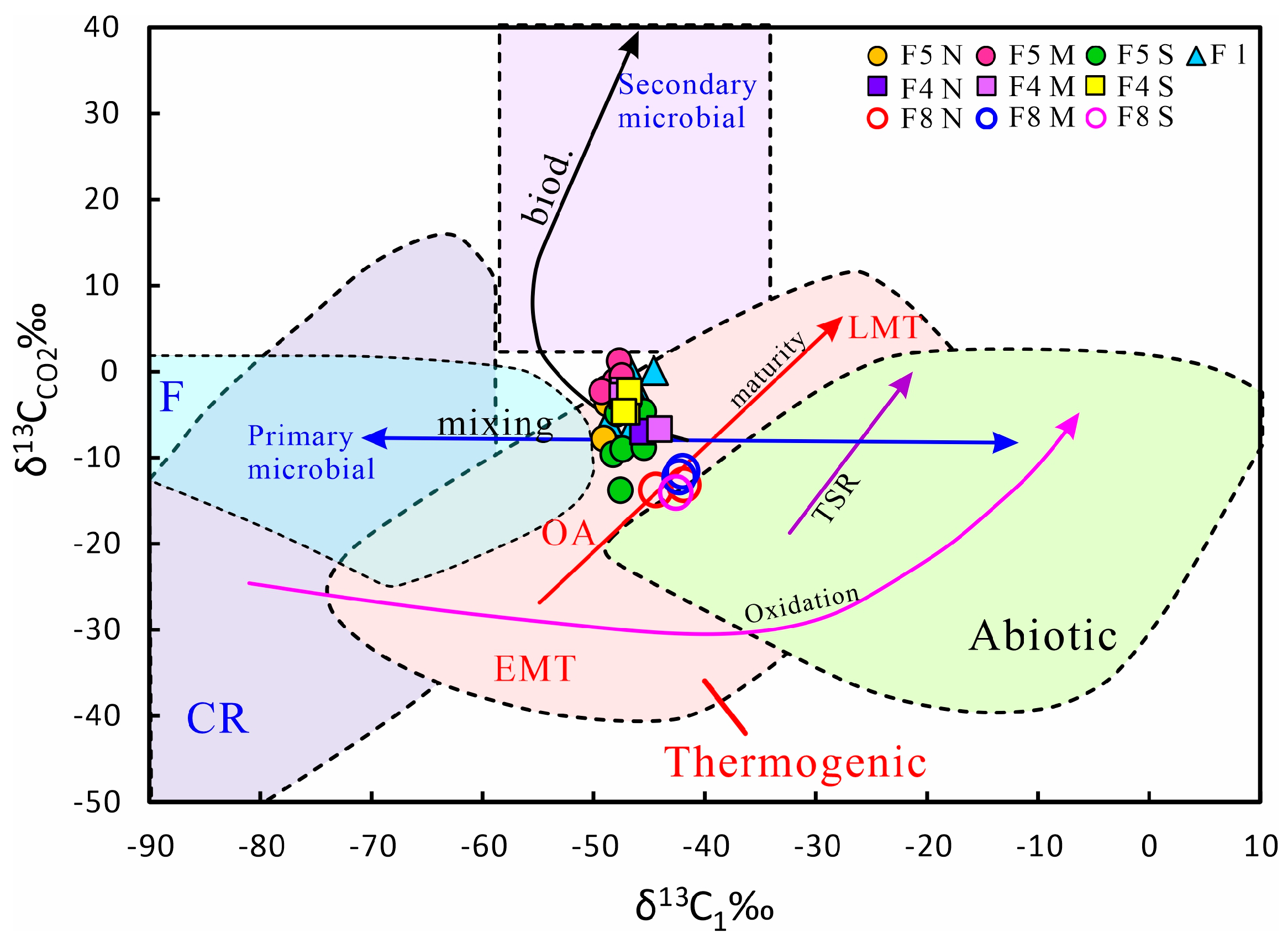


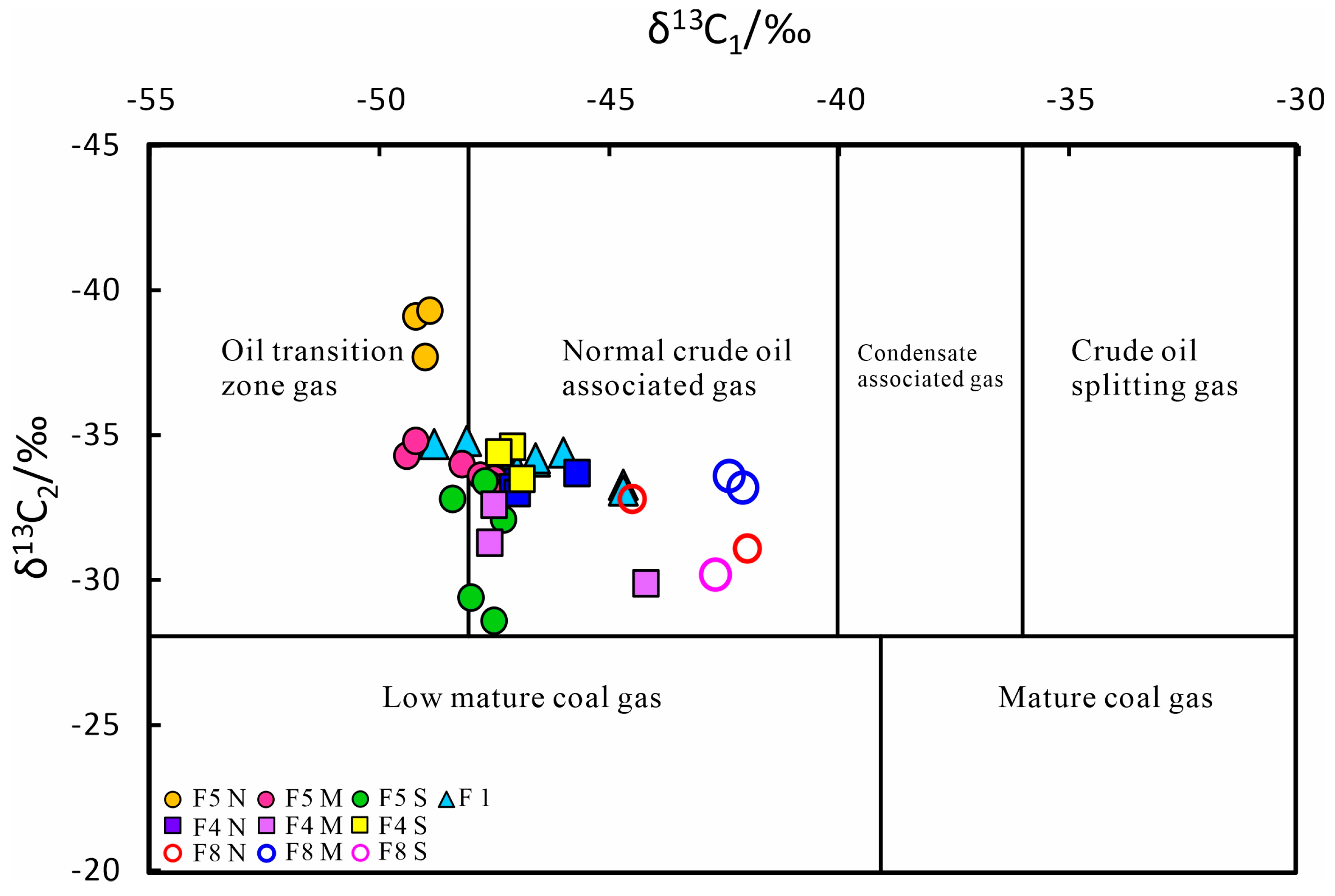
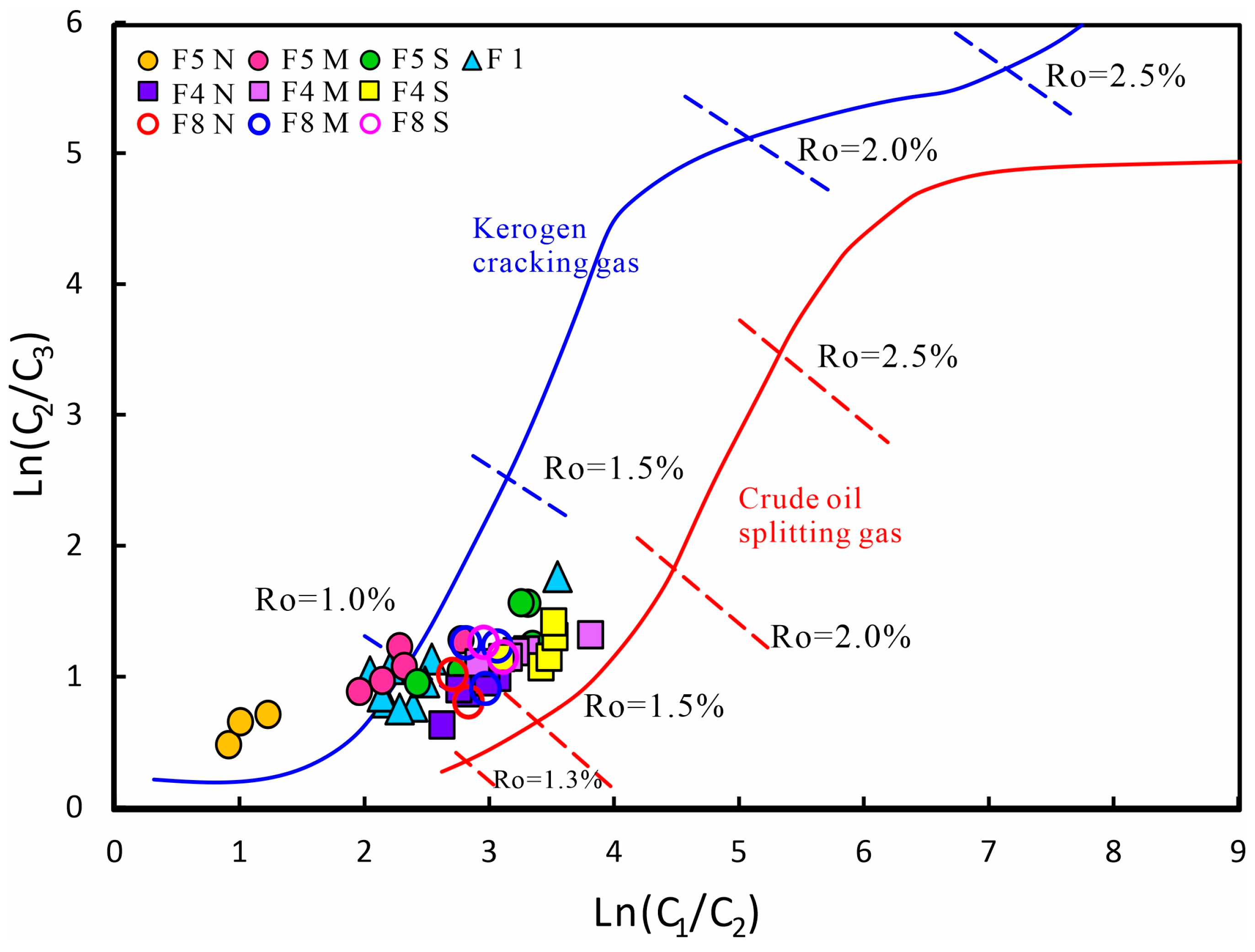
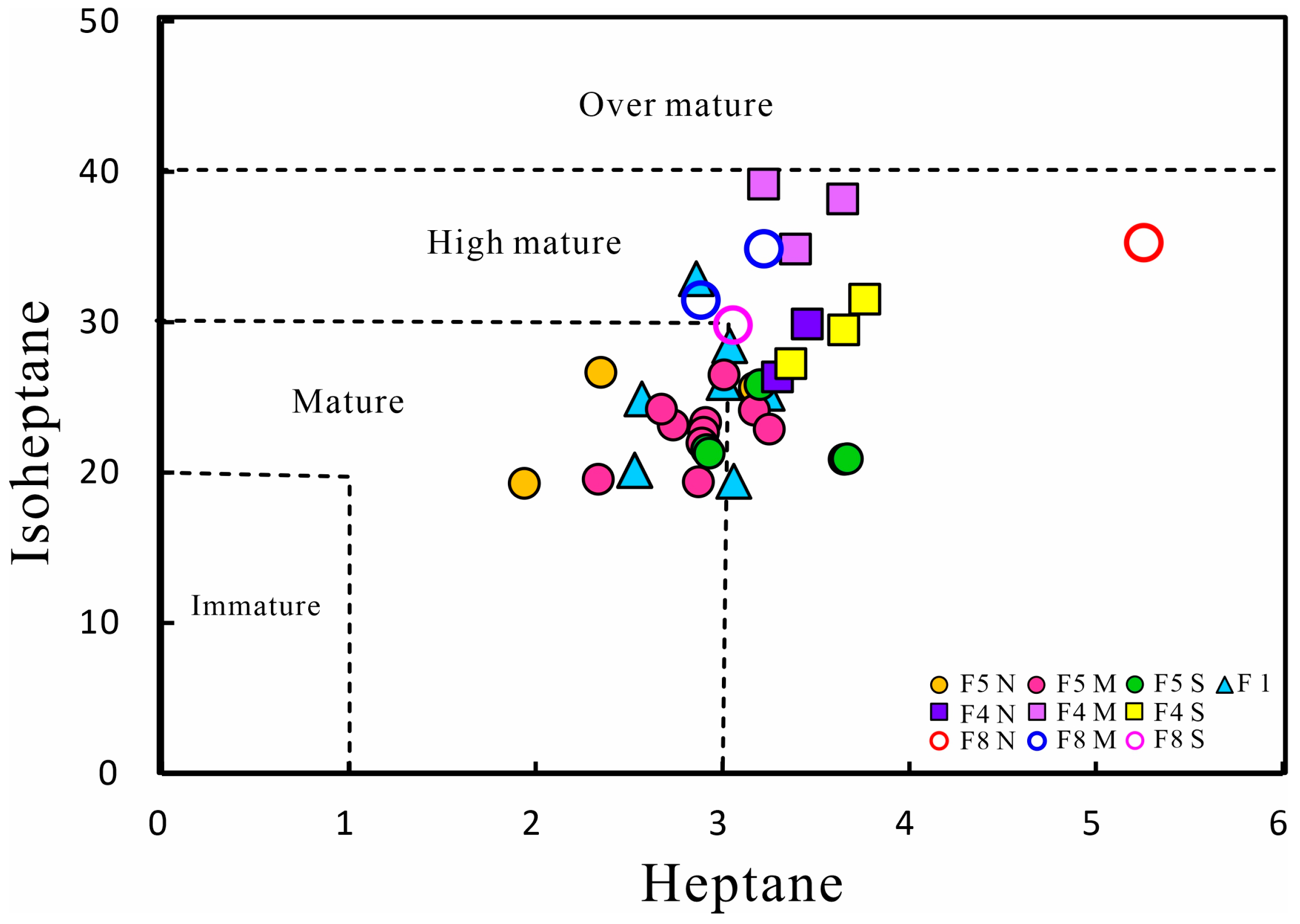

| Chemical Composition/% | Dryness Index | ||||||||||||||
|---|---|---|---|---|---|---|---|---|---|---|---|---|---|---|---|
| Region | Well | Depth/m | Formation | C1 | C2 | C3 | iC4 | nC4 | iC5 | nC5 | O2 | N₂ | CO2 | H₂ | (C1/C1~C5) (%) |
| Fault 1 | S1-3 | 7274–7358 | O2yj | 70.98 | 5.59 | 1.77 | 0.32 | 0.48 | 0.12 | 0.12 | 0.30 | 10.41 | 2.08 | 7.77 | 0.894 |
| S1 * | 7269–7320 | O2yj+O1−2y | 84.18 | 2.43 | 0.41 | 0.03 | 0.06 | - | - | - | 1.55 | 11.01 | 0.32 | 0.966 | |
| S1-1 | 7268–7318 | O2yj | 82.89 | 7.57 | 3.43 | 0.69 | 0.91 | 0.19 | 0.14 | 0.00 | 1.49 | 2.70 | 0.00 | 0.865 | |
| S1-23H | 7495–8070 | O2yj+O1−2y | 67.76 | 7.45 | 2.54 | 0.38 | 0.90 | 0.18 | 0.33 | - | 2.53 | 16.36 | 1.58 | 0.852 | |
| S1-4H | 7459–7562 | O2yj | 80.35 | 9.05 | 3.98 | 0.70 | 1.01 | 0.21 | 0.19 | - | 2.20 | 2.32 | 0.00 | 0.841 | |
| S1-11 | 7572–7732 | O2yj | 71.78 | 8.39 | 3.53 | 0.64 | 1.04 | 0.23 | 0.26 | 0.52 | 10.23 | 3.17 | 0.06 | 0.836 | |
| S1-14 | 7589–7710 | O2yj | 73.66 | 9.47 | 3.31 | 0.52 | 0.78 | 0.16 | 0.17 | 2.32 | 7.82 | 1.68 | 0.08 | 0.837 | |
| S1-9 | 7372–7630 | O2yj+O1−2y | 81.80 | 6.80 | 2.56 | 0.53 | 0.83 | 0.24 | 0.25 | 0.53 | 4.08 | 2.22 | 0.01 | 0.879 | |
| S1-8H | 7415–7571 | O2yj | 77.42 | 7.86 | 3.64 | 0.82 | 1.43 | 0.41 | 0.44 | 0.60 | 4.59 | 2.52 | 0.02 | 0.841 | |
| The north section of F5 | S5-4 | 7393–7480 | O2yj | 43.70 | 17.34 | 10.56 | 1.35 | 2.86 | 0.49 | 0.63 | 0.54 | 15.72 | 6.12 | 0.17 | 0.568 |
| S5 | 7314–7650 | O2yj+O1−2y | 47.13 | 17.02 | 8.71 | 1.27 | 2.15 | 0.37 | 0.43 | 0.68 | 16.97 | 5.09 | 0.01 | 0.612 | |
| S5-2 * | 7460–7527 | O2yj | 62.06 | 18.00 | 8.70 | 1.08 | 1.90 | 0.32 | 0.33 | - | 2.36 | 5.05 | 0.19 | 0.672 | |
| The middle section of F5 | S5-6 | 7555 | O2yj | 87.17 | 6.16 | 0.59 | 0.02 | 0.02 | 0.01 | 0.01 | 0.28 | 3.08 | 2.60 | 0.04 | 0.928 |
| S5-7 | 7562–7635 | O2yj+O1−2y | 80.14 | 9.34 | 3.49 | 0.47 | 0.94 | 0.11 | 0.12 | - | 3.82 | 1.65 | 0.01 | 0.847 | |
| S5-10 | 7639–8038 | O2yj+O1−2y | 82.21 | 8.36 | 2.41 | 0.27 | 0.44 | 0.06 | 0.00 | - | 4.18 | 2.07 | 0.01 | 0.877 | |
| S5-15H | 7632–7877 | O2yj+O1−2y | 83.25 | 8.15 | 2.73 | 0.37 | 0.62 | 0.09 | 0.09 | - | 2.52 | 2.15 | 0.02 | 0.874 | |
| S5-5H | 8200 | O2yj | 74.17 | 10.39 | 4.21 | 0.78 | 1.28 | 0.32 | 0.35 | 0.31 | 5.91 | 2.14 | 0.01 | 0.811 | |
| S5-9 | 7648–7839 | O2yj | 47.57 | 2.96 | 0.81 | 0.12 | 0.32 | 0.08 | 0.15 | 0.00 | 0.00 | 47.80 | 0.19 | 0.915 | |
| S52A | / | O2yj | 39.67 | 27.07 | 20.32 | 3.15 | 4.94 | 0.60 | 0.45 | 0.00 | 0.00 | 3.80 | 0.00 | 0.412 | |
| The southern section of F5 | S53X | 7740–8342 | O2yj+O1−2y | 80.15 | 7.06 | 2.68 | 0.57 | 1.16 | 0.23 | 0.32 | - | 0.82 | 6.68 | 0.15 | 0.870 |
| S53-1H | / | O2yj | 86.78 | 5.44 | 1.88 | 0.37 | 0.73 | 0.15 | 0.19 | 0.00 | 0.62 | 3.81 | 0.04 | 0.908 | |
| S53-2H | / | O2yj | 87.90 | 3.21 | 0.66 | 0.17 | 0.30 | 0.00 | 0.13 | 0.00 | 1.71 | 5.79 | 0.14 | 0.952 | |
| S53-7H | / | O2yj | 91.27 | 0.65 | 0.08 | 0.00 | 0.00 | 0.00 | 0.00 | 0.00 | 1.00 | 6.95 | 0.05 | 0.992 | |
| S55X | / | O2yj | 77.53 | 2.73 | 0.77 | 0.24 | 0.33 | 0.15 | 0.14 | 1.63 | 6.80 | 9.61 | 0.02 | 0.947 | |
| S56X | / | O2yj+O1−2y | 71.23 | 0.03 | 0.02 | 0.00 | 0.00 | 0.00 | 0.00 | 0.23 | 6.17 | 22.11 | 0.10 | 0.999 | |
| S57X | / | O2yj+O1−2y | 88.20 | 3.40 | 0.70 | 0.28 | 0.31 | 0.11 | 0.07 | 0.12 | 1.32 | 5.36 | 0.45 | 0.948 | |
| The north section of F4 | S43X | 7558–7995 | O2yj+O1−2y | 82.41 | 4.88 | 2.00 | 0.67 | 0.94 | 0.39 | 0.40 | 0.20 | 2.47 | 5.46 | 0.00 | 0.899 |
| S44X | / | O2yj | 75.65 | 5.48 | 2.87 | 0.98 | 1.59 | 0.64 | 0.66 | 1.09 | 6.61 | 4.16 | 0.00 | 0.861 | |
| S4-5H | / | O1−2y | 83.67 | 5.30 | 2.10 | 0.58 | 0.83 | 0.32 | 0.33 | 0.00 | 1.51 | 4.63 | 0.72 | 0.898 | |
| S4-9H | 7600–8110 | O2yj+O1−2y | 89.68 | 4.16 | 1.51 | 0.42 | 1.04 | 0.38 | 0.59 | 0.00 | 0.64 | 1.55 | 0.03 | 0.917 | |
| S45X | 7664–8845 | O2yj+O1−2y | 75.89 | 3.85 | 1.45 | 1.22 | 0.61 | 0.26 | 0.24 | 0.46 | 8.11 | 6.66 | 1.15 | 0.909 | |
| The middle section of F4 | S4-4H | 7555–8591 | O2yj+O1−2y | 80.86 | 4.40 | 1.43 | 0.39 | 0.76 | 0.25 | 0.39 | 0.00 | 0.20 | 11.27 | 0.04 | 0.914 |
| S41X | / | O2yj | 81.25 | 2.99 | 0.88 | 0.34 | 0.37 | 0.21 | 0.17 | 0.81 | 3.65 | 9.20 | 0.00 | 0.942 | |
| S4-2H | 7551–8587 | O2yj+O1−2y | 82.88 | 3.33 | 1.00 | 0.30 | 0.57 | 0.23 | 0.36 | 0.00 | 0.14 | 11.18 | 0.01 | 0.935 | |
| S46X | / | O2yj+O1−2y | 82.24 | 3.49 | 1.09 | 0.38 | 0.41 | 0.24 | 0.21 | 0.40 | 3.10 | 8.20 | 0.07 | 0.934 | |
| S4 | 7777 | O2yj+O1−2y | 86.15 | 1.91 | 0.50 | 0.10 | 0.20 | 0.00 | 0.00 | 0.00 | 1.93 | 8.96 | 0.26 | 0.970 | |
| The southern section of F4 | S42X | / | O2yj+O1−2y | 79.79 | 2.62 | 0.88 | 0.32 | 0.44 | 0.23 | 0.23 | 0.47 | 4.27 | 9.10 | 1.49 | 0.944 |
| S47X | / | O2yj+O1−2y | 83.49 | 2.58 | 0.81 | 0.31 | 0.39 | 0.26 | 0.27 | 0.76 | 3.84 | 7.04 | 0.00 | 0.948 | |
| S4-13H | / | O2yj+O1−2y | 86.29 | 2.54 | 0.68 | 0.28 | 0.40 | 0.23 | 0.21 | 0.00 | 0.00 | 9.35 | 0.02 | 0.952 | |
| S4-3H | 7386–8179 | O2yj+O1−2y | 84.77 | 2.52 | 0.60 | 0.10 | 0.19 | 0.00 | 0.00 | 0.00 | 0.17 | 11.64 | 0.01 | 0.961 | |
| S4-1H | / | O2yj | 77.70 | 3.49 | 1.10 | 0.23 | 0.48 | 0.12 | 0.17 | 0.00 | 0.37 | 16.16 | 0.17 | 0.933 | |
| The north of F8 | S83X | 7726–8543 | O2yj+O1−2y | 87.58 | 5.16 | 2.26 | 0.61 | 0.78 | 0.00 | 0.23 | - | 1.19 | 1.95 | 0.05 | 0.906 |
| S84X | 8400–9195 | O2yj+O1−2y | 86.57 | 5.79 | 2.05 | 0.52 | 0.56 | 0.00 | 0.17 | - | 1.65 | 2.08 | 0.49 | 0.905 | |
| The middle of F8 | S802X | 7827–8396 | O2yj+O1−2y | 88.54 | 4.14 | 1.18 | 0.34 | 0.38 | 0.13 | 0.10 | 0.27 | 2.61 | 2.25 | 0.00 | 0.934 |
| S801X | 7691 | O2yj+O1−2y | 84.78 | 5.09 | 1.42 | 0.45 | 0.50 | 0.00 | 0.19 | 0.20 | 1.71 | 5.63 | 0.03 | 0.917 | |
| S8X | 7737–8396 | O2yj+O1−2y | 85.56 | 4.39 | 1.74 | 0.61 | 0.90 | 0.35 | 0.35 | 0.45 | 2.66 | 2.77 | 0.06 | 0.911 | |
| The southern of F8 | S803X | 7659–8110 | O2yj+O1−2y | 88.40 | 3.96 | 1.23 | 0.42 | 0.48 | 0.14 | 0.20 | 0.23 | 1.29 | 2.69 | 0.03 | 0.932 |
| S82X | 7617–8262 | O2yj+O1−2y | 89.20 | 4.64 | 1.29 | 0.43 | 0.52 | 0.22 | 0.22 | 0.14 | 0.97 | 2.19 | 0.02 | 0.924 | |
| S81X | 7466–8308 | O2yj+O1−2y | 93.02 | 1.47 | 0.38 | 0.16 | 0.17 | 0.09 | 0.08 | - | 0.41 | 4.15 | 0.07 | 0.975 | |
| δ13CPDB (‰) | δDVsmow/‰ | ||||||||||||
|---|---|---|---|---|---|---|---|---|---|---|---|---|---|
| Region | Well | Depth/m | C1 | C2 | C3 | iC4 | nC4 | CO2 | δD1 | δD2 | δD3 | Ro1/% | Ro2/% |
| F1 | S1-3 * | 7274–7358 | −44.7 | −33.3 | −30.8 | −34.2 | −29 | 0.1 | −170 | −140 | −116 | 0.87 | 1.10 |
| S1 * | 7269–7320 | −44.7 | −33.1 | −30.8 | −31.8 | −29.8 | / | −157 | −127 | / | 0.87 | 1.10 | |
| S1-1 | 7268–7318 | −46 | −34.4 | −32.1 | −32.4 | −31.4 | −2.8 | −161 | −111 | −105 | 0.76 | 0.96 | |
| S1-23H | 7495–8070 | −48.1 | −34.8 | −32.3 | −32.9 | −32 | / | −178 | / | / | 0.61 | 0.77 | |
| S1-4H | 7459–7562 | −47 | −33.8 | −31.6 | −35.2 | −29.4 | 0.5 | −180 | −148 | −116 | 0.68 | 0.86 | |
| S1-11 * | 7572–7732 | −46.6 | −34.1 | −32 | −32.4 | −31.4 | −6.4 | −156 | −113 | −104 | 0.71 | 0.90 | |
| S1-14 * | 7589–7710 | −48.8 | −34.7 | −32.2 | −33 | −31.5 | −5.9 | −162 | −110 | −101 | 0.56 | 0.71 | |
| S1-9 | 7372–7630 | −46.6 | −34.2 | −31.9 | −31.9 | −31.2 | −2.1 | −166 | −111 | −104 | 0.71 | 0.90 | |
| S1-8H | 7415–7571 | −47.2 | −33.8 | −31.2 | −31.9 | −30.7 | −1.4 | −169 | −111 | −101 | 0.67 | 0.85 | |
| The north of F5 | S5-4 * | 7393–7480 | −49.2 | −39.1 | −35.1 | −33.9 | −33.1 | −7.8 | −205 | −195 | −157 | 0.54 | 0.68 |
| S5 * | 7314–7650 | −48.9 | −39.3 | −35.6 | −34.6 | −33.4 | −3.7 | −207 | −180 | −141 | 0.56 | 0.71 | |
| S5-2 * | 7460–7527 | −49 | −37.7 | −34.1 | −33.9 | −32.2 | −2 | / | / | / | 0.55 | 0.70 | |
| The middle of F5 | S51X | 7553–7876 | −48.2 | −34 | −31.2 | −31.1 | −29.6 | −1.1 | −183 | −135 | −107 | 0.60 | 0.76 |
| S5-7 | 7562–7635 | −47.8 | −33.6 | −30.9 | −31.1 | −29.7 | 1.2 | −182 | −131 | −110 | 0.63 | 0.79 | |
| S5-10 | 7639–8038 | −47.5 | −33.5 | −30.7 | −31.8 | −29.4 | −1.1 | −182 | −128 | −102 | 0.65 | 0.82 | |
| S5-15H | 7632–7877 | −47.6 | −33.3 | −30.6 | −30.8 | −29.5 | −0.5 | −180 | −127 | −102 | 0.64 | 0.81 | |
| S5-9 | 7648–7839 | −49.4 | −34.3 | −31.7 | −32.1 | −31.7 | −2.3 | −181 | / | / | 0.53 | 0.67 | |
| S52A | / | −49.2 | −34.8 | −32.4 | −33.4 | −31.8 | / | −189 | −135 | −121 | 0.54 | 0.68 | |
| The southern of F5 | S53X | 7740–8342 | −47.7 | −33.4 | −31.7 | −31.4 | −30.4 | −13.8 | −159 | / | / | 0.63 | 0.80 |
| S53-1H | / | −48.4 | −32.8 | −30.4 | −31 | −29.9 | −9.6 | −168 | −123 | −114 | 0.59 | 0.74 | |
| S53-2H | / | −47.5 | −28.6 | −25.4 | −27.8 | −26.3 | −9 | −156 | −105 | −94 | 0.65 | 0.82 | |
| S53-7H | / | −45.6 | −28.2 | −27.2 | −27.3 | −27.4 | −8.8 | −150 | −102 | / | 0.79 | 1.00 | |
| S55X | / | −47.3 | −32.1 | −29.3 | −31.2 | −29.2 | −4.1 | −162 | −120 | −110 | 0.66 | 0.84 | |
| S56X | / | −45.6 | −26.3 | / | / | / | −4.7 | −152 | / | / | 0.79 | 1.00 | |
| S57X | / | −48 | −29.4 | −27.2 | −28.6 | −27.9 | −4.9 | / | / | / | 0.61 | 0.78 | |
| The north of F4 | S43X | 7558–7995 | −47 | −33.4 | −29.6 | −30.4 | −28.7 | −2.5 | −159 | −114 | 0.68 | 0.86 | |
| S44X | / | −45.7 | −33.7 | −30.9 | −32 | −30.7 | −7 | −160 | −121 | −110 | 0.78 | 0.99 | |
| S4-9H | 7600–8110 | −47.1 | −33.2 | −30.3 | −31.5 | −30.6 | −2.3 | −163 | −110 | / | 0.68 | 0.85 | |
| S45X | 7664–8845 | −47 | −33 | −29.4 | −30.8 | −29.1 | −2.6 | −159 | −109 | / | 0.68 | 0.86 | |
| The middle of F4 | S4-4H | 7555–8591 | −47.5 | −32.6 | −28.4 | −29.9 | −27.9 | −2.2 | −148 | −109 | / | 0.65 | 0.82 |
| S4-2H | 7551–8587 | −47.6 | −31.3 | −26.5 | −27.8 | −26.4 | −2.8 | / | / | / | 0.64 | 0.81 | |
| S4 | 7777 | −44.2 | −29.9 | −27.5 | −26.2 | −26.5 | −6.7 | −151 | −99 | −81 | 0.92 | 1.16 | |
| The southern of F4 | S4-13H | / | −47.1 | −34.6 | −29.9 | −31.5 | −29.9 | −4.7 | / | / | / | 0.68 | 0.85 |
| S4-3H | 7386–8179 | −46.9 | −33.5 | −28.9 | −30.4 | −28.1 | −2.3 | −146 | −99 | / | 0.69 | 0.87 | |
| S4-1H | / | −47.4 | −34.4 | −29.8 | −31.9 | −30.1 | −4.7 | −163 | −115 | −109 | 0.65 | 0.83 | |
| F8 north | S83X | 7726–8543 | −44.5 | −32.8 | −30.8 | / | / | −13.8 | / | / | / | 0.86 | 1.09 |
| S84X | 8400–9195 | −42.0 | −31.1 | −28.9 | / | / | −13.2 | / | / | / | 1.12 | 1.42 | |
| F8 middle | S802X * | 7827–8396 | −42.1 | −33.2 | −31.9 | −32.5 | −30.7 | −11.6 | / | / | / | 1.15 | 1.45 |
| S8X * | 7737–8396 | −42.4 | −33.6 | −31.7 | −32.4 | −31.7 | −12.3 | / | / | / | 1.11 | 1.40 | |
| F8 southern | S803X | 7659–8110 | −42.7 | −30.2 | −27.7 | / | / | −14.1 | / | / | / | 1.36 | 1.71 |
Disclaimer/Publisher’s Note: The statements, opinions and data contained in all publications are solely those of the individual author(s) and contributor(s) and not of MDPI and/or the editor(s). MDPI and/or the editor(s) disclaim responsibility for any injury to people or property resulting from any ideas, methods, instructions or products referred to in the content. |
© 2024 by the authors. Licensee MDPI, Basel, Switzerland. This article is an open access article distributed under the terms and conditions of the Creative Commons Attribution (CC BY) license (https://creativecommons.org/licenses/by/4.0/).
Share and Cite
Long, H.; Zeng, J.; Liu, Y.; Li, C. Geochemical Characteristics and Origin of Natural Gas in the Middle of Shuntuoguole Low Uplift, Tarim Basin: Evidence from Natural Gas Composition and Isotopes. Energies 2024, 17, 4261. https://doi.org/10.3390/en17174261
Long H, Zeng J, Liu Y, Li C. Geochemical Characteristics and Origin of Natural Gas in the Middle of Shuntuoguole Low Uplift, Tarim Basin: Evidence from Natural Gas Composition and Isotopes. Energies. 2024; 17(17):4261. https://doi.org/10.3390/en17174261
Chicago/Turabian StyleLong, Hui, Jianhui Zeng, Yazhou Liu, and Chuanming Li. 2024. "Geochemical Characteristics and Origin of Natural Gas in the Middle of Shuntuoguole Low Uplift, Tarim Basin: Evidence from Natural Gas Composition and Isotopes" Energies 17, no. 17: 4261. https://doi.org/10.3390/en17174261
APA StyleLong, H., Zeng, J., Liu, Y., & Li, C. (2024). Geochemical Characteristics and Origin of Natural Gas in the Middle of Shuntuoguole Low Uplift, Tarim Basin: Evidence from Natural Gas Composition and Isotopes. Energies, 17(17), 4261. https://doi.org/10.3390/en17174261





